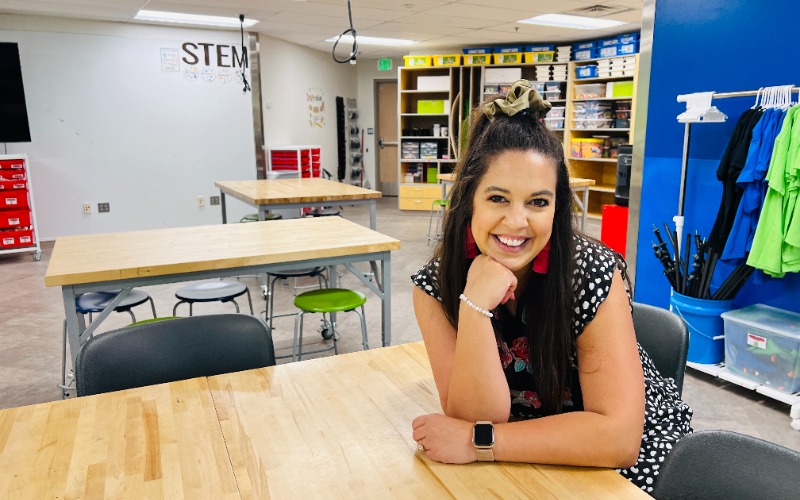
[ad_1]
“Once I develop up, I wish to be a STEM instructor!”
These weren’t the phrases that got here out of my mouth after I was 5 years previous. I at all times dreamed of being a instructor, however being a STEM instructor was not within the plan. STEM wasn’t even a factor after I was just a little child!
My desires ultimately got here true, and I landed a task instructing 2nd grade. Quick ahead to me instructing within the classroom for six years (2nd and third grade) after which touchdown a place instructing Ok-5 STEM.
I used to be granted a model new classroom with restricted provides and 0 curriculum. I didn’t know a soul within the constructing. My function was to show revolutionary classes to all the five hundred+ youngsters within the college, handle school-wide know-how, and co-teach with the lecturers in my building- such a simple feat, proper?
As classes have been developed and provides collected, the scholars turned fascinated by what STEM might be of their elementary world. We coded robots, constructed prototypes from recycled supplies, and even took our studying outdoors with my distinctive unit, STEM Survival Camp.
By means of my years instructing Ok-5 STEM, I noticed that this chance for college kids was much less concerning the instruments. Somewhat, it was extra concerning the life expertise that youngsters have been growing throughout their time with me.
I even advised my college students this. So what does STEM training educate our college students? Right here’s my take.
Resilience
We predict not giving up when issues are exhausting is an innate talent. It’s not. I don’t have sufficient fingers to depend the variety of instances children cried when a chunk of their challenge didn’t work the primary time, they usually wished to surrender.
We have to present our college students with numerous alternatives to try to fail a number of instances. Not solely that however having the ability to try to fail with totally different mediums is important. Some college students excel at 3D print design however get pissed off when constructing with cardboard. College students have to face challenges, learn to overcome them, and perceive that not all the pieces will likely be simple. That’s okay! Life isn’t simple, and we want children who can persist, even when a problem doesn’t work or it’s exhausting.
Collaboration
As college students turned accustomed to my class, we thrived within the collaboration division. For initiatives, college students held varied roles when fixing an issue. For instance, with LEGO constructing, we might have a “Builder,” a “Finder,” and a “Director.” Whereas it was a course of, college students have been greedy the talent of collaborating.
Then the pandemic occurred. After we returned to in-person instructing, quite a bit shocked me, however the collaboration piece shocked me probably the most. I used to have comfy classmates asking each other for options, and I used to be the information all through the method. In distinction, college students have been extremely depending on me. They hardly thought to ask the individual sitting subsequent to them who was engaged on the identical challenge.
We frequently take as a right how necessary human connection is, however the talent of collaboration is one which even impacts elementary-aged youngsters and is one thing we now have to proceed to work on.
Creativity
Kindergarteners, particularly, have been my most inventive group of scholars yr after yr. They’re so happy with the concepts they provide you with, even when it wasn’t possible. Everybody has a spark of creativity in their very own distinctive method. Some college students are wonderful storytellers.
I had one scholar engaged on our LEGO builds who liked so as to add in The Individuals (mini figures), give them names, and create an entire scene for them. One other scholar, who jogged my memory of a Disney Imagineer, added immense element to our makerspace challenges after we mixed robotics. Likewise, I had one other scholar who added enjoyable jokes and music to their coding tales.
The world wants a number of views when pondering of the world in new methods. STEM brings out these inside passions in college students and helps them apply their creativity in new conditions.
Empathy
I hardly hear the phrase usually utilized by college students, “Why do we now have to study this?” in my STEM classroom. Why? Because the instructor, I’d ask them that actual query: What’s the level of doing any of this?
I used to be engaged on a 3D printing challenge with fifth graders, an age that may generally be exhausting to attach with, and we have been speaking about Earth’s sources. From there, we mentioned several types of depleted pure sources and varied points which might be dealing with our surroundings.
Vital, sure, however I wished college students to know the influence as to why our selections as people, good or dangerous, make a distinction. By shifting this attitude, college students have been extra enthusiastic about their last design and why it was impactful to make a change. Having college students see outdoors of themselves and having compassion for others by design can join their studying to an even bigger objective.
Whereas there’s a massive push to incorporate STEM and revolutionary lessons beginning in center and highschool, how are we reaching our youngest learners? Not solely do our college students have to have the expertise utilizing present instruments, but additionally distinctive alternatives to apply comfortable expertise. Whereas these expertise can nonetheless be labored on in a conventional classroom setting, including a component of hands-on studying and innovation can add a brand new and difficult perspective.
When asking why elementary youngsters want a STEM class, take into account the alternatives much less concerning the cute robotic and extra concerning the expertise that college students have to succeed for as we speak and their futures.
[ad_2]
Supply hyperlink




